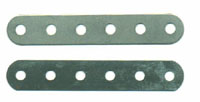While Meccano first appeared in the US looking the same as it did in England, it diverged through the years to become distinguishable from the original British production. At first, the only difference (at least, the only one that I have been able to identify) was the manuals - they were "American Editions," with US prices, and the name of the importer (The Embossing Company of Albany, NY). The manuals were otherwise the same as those printed in England, and the parts, of course, came from England. When the Meccano Company, Inc. was formed in New York in 1913, the New York address started to appear on the manuals. In 1915, the first US manufactured parts appeared: the 4 volt motor, in reversing (E2) and non-reversing (E1) versions. With this introduction, a new manual was printed. The models illustrated were the same as in the 1914 manual, but the outfit price list was expanded to include the "x" outfits (1x, 2x, and 3x), which added the electric motor to the regular outfits (1, 2, and 3 respectively). No 1915 manuals were printed in England (at least, none have been identified). From 1915, the systems diverged more and more. The main 1916 US manual, for example, does not quite match any of the English versions.
 When production started in the factory in Elizabeth, NJ, the parts were similar but not quite identical. Tin was used to plate many of the parts, instead of nickel. More interestingly, the ends of the strips were not fully rounded, as they were in England. The scan shows a strip from Liverpool above, and from Elizabeth below. (Click on the scan or here for a larger version.) The Liverpool strip is bright nickel plated, while the Elizabeth strip is tin plated. In most cases, the tin plating has tarnished to a gray color, similar to that in the scan. Sometimes, the tin is still found in its original bright shining condition, and one has to be careful to avoid confusion with nickel. The difference is apparent, especially when the two finishes are compared side-by-side. Note that 12 1/2" strips, both from Elizabeth and Liverpool, all had the "corners" similar to those shown on the Elizabeth strip above. When production started in the factory in Elizabeth, NJ, the parts were similar but not quite identical. Tin was used to plate many of the parts, instead of nickel. More interestingly, the ends of the strips were not fully rounded, as they were in England. The scan shows a strip from Liverpool above, and from Elizabeth below. (Click on the scan or here for a larger version.) The Liverpool strip is bright nickel plated, while the Elizabeth strip is tin plated. In most cases, the tin plating has tarnished to a gray color, similar to that in the scan. Sometimes, the tin is still found in its original bright shining condition, and one has to be careful to avoid confusion with nickel. The difference is apparent, especially when the two finishes are compared side-by-side. Note that 12 1/2" strips, both from Elizabeth and Liverpool, all had the "corners" similar to those shown on the Elizabeth strip above.
Another very subtle difference is the size of the bolts and nuts. British Meccano used 5/32 BSW (5/32 inch British Standard Whitworth) threads. Sometime around perhaps 1920, US Meccano started using #7-32 NC threads. These are very close to the same size, but do not always work with each other. |